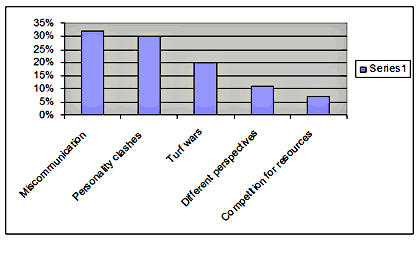By AMA Staff
In a famous chapter in Mark Twain’s classic Huckleberry Finn, Huck comes to stay with the Grangerfords, a family who for generations has been feuding with another local family, the Shepherdsons. Even when going to the local church, the families continue their feud: “The men took their guns along…and kept them between their knees or stood them handy against the wall,” says Huck. “The Shepherdsons done the same. It was pretty ornery preaching—all about brotherly love, and such-like…”
Transpose the church setting to a modern-day meeting room, and the warring families to grudge-holding colleagues, and you have a pretty accurate description of the tenacious nature of office feuds. Indeed, one can even picture the CEO holding forth at a company meeting on the topics of “brotherly love” and teamwork while the feuding factions eye each other and keep their metaphoric guns close at hand.
The scenario plays out time and time again, even at the highest levels of management, where one would hope that such counterproductive behavior isn’t tolerated. Virtually every month, however, it seems that there’s some new story about feuding executives and the damage they wreak. In the most extreme cases, the outcome can be devastating.
Even when the results aren’t that drastic, however, office feuds are a costly waste of energy and time. How do these destructive quarrels get started? Here’s what Performance & Profits readers said were the most common causes of conflict at work:

Whatever their original cause, however, office feuds often take on a life of their own. There’s a variety of reasons for this self-perpetuating nature. One of the chief reasons is that people enjoy feuding. Let’s be honest: few things make for better entertainment than a good old-fashioned office feud. The warring factions often embrace the adrenaline-filled tension and hostility, while spectators enjoy all the fireworks and drama. It becomes a favorite topic of gossip and speculation, and the various machinations are reported endlessly.
Another reason feuds persist is that negative behavior is highly virulent. The old saying “a smile is contagious” might sound nice, but it’s not true, at least according to researchers at the University of Washington, who found that one negative co-worker can destroy a good team. Conversely, one or two good workers can't undo the damage. If one contentious teammate can cause that much harm, imagine what dueling rivals can inflict on an office.
You can’t prevent conflicts from occurring, but here are 10 tactics you can use to lessen their impact.
- Avoid the disagreement. Unless the conflict is impacting the disputants' work within your department or work done for your unit, stay out of the conflict if you can do so.
- Bring in a third-party mediator or negotiator. If the disputants are your staff members, you may have to serve in this role. If the conflict involves your peers, you may want to suggest they seek out someone higher up in the organization to mediate. Again, it is better if you can stay out of it. No matter how fair the final compromise, neither party is likely to be happy with the role you played.
- Remove the condition creating the conflict. The assumption is that you have some control over the cause of the conflict. Sometimes, eliminating a rule or other causal factor is less costly than the disagreement it's causing.
- Smooth over the differences. Okay, you can't get out of being involved. If you must be involved, try to get the parties in conflict to realize that their differences are not that great. If the disputants are within your department, find ways to appease each person and make the individual less insistent on his or her points.
- Focus the parties on the bigger picture. Draw the combatants' attention to the common stakes they have in finding an end to the conflict.
- Focus on the issues. Get the parties to dispense with name calling and other personality bear baitings and focus, instead, on the substance of their disagreement. Frequently, redirecting the conflict to the issues puts a quick end to the conflict.
- Identify misunderstandings. It's amazing how often they are at the root of disputes.
- Undertake fact finding. Or, rather, determine what are the facts. Some "facts" have no basis in reality.
- Get the antagonists to put themselves in the other person's shoes. Reversing roles may help each party better understand the other's viewpoint—and such awareness may be all that is needed to end the dispute.
- Force the end of hostilities. You can do this with direct reports. Point out to staff members that a continuation of their dispute will be reflected in their performance assessment. You might remind colleagues that their behavior may be seen as childish by those in authority and your peers would be better off if they put aside their disagreement.
About The Author(s)
American Management Association is a world leader in professional development, advancing the skills of individuals to drive business success. AMA’s approach to improving performance combines experiential learning—“learning through doing”—with opportunities for ongoing professional growth at every step of one’s career journey. AMA supports the goals of individuals and organizations through a complete range of products and services, including seminars, Webcasts and podcasts, conferences, corporate and government solutions, business books and research.